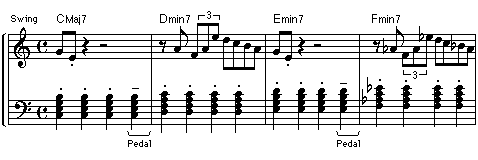(Down - Up - Top)
KT Song 7 - Bop It
Bop It (Audio) is an up tempo Swing tune. Therefore swing all quavers and apply the appropriate staccatos.
In most piano playing the hands are relaxed but quite mobile. They jump up and down, rather like bouncing balls, shaping the musical phrases with their movements.
Swing staccatos are ideal spring boards for the hand to jump from one phrase to the next. This produces nice crisp staccato notes, shapes the music phrase and ensures a good relaxed technique motion.
Audio 11.7

Bop It contains many syncopations in both the right and the left hand.
Practise therefore the right hand melody first, accompanied by light staccato crotchet chords on each beat in the left hand.
A nice effect in this simple accompaniment is to pedal the occasional chord on the 4th beat in the bar.
Audio 11.7

Once you have the right hand melody down add the written left hand to your practice.
When you can play Bop It as written, experiment a bit an work out your own left hand accompaniment for this song.
(Down - Up - Top)
KT Song 8 - Song Materials
Play all songs both with and without the backing tracks.
(Up - Top - ? ?)
© 1999 Michael Furstner (Jazclass)